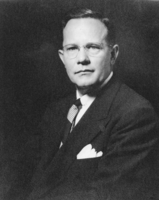 | Back to e-WV
| Back to e-WV
 The West Virginia Encyclopedia
The West Virginia Encyclopedia
 | Back to e-WV
| Back to e-WV
 The West Virginia Encyclopedia
The West Virginia Encyclopedia

Clarence Watson Meadows (February 11, 1904-September 12, 1961) was the 22nd governor of West Virginia. He was born in Beckley. His mother hoped he would become a Baptist minister, but he ultimately followed his father’s bent and entered politics. While growing up, Clarence often appeared in minstrel shows, comedies, and dramas in his community. His penchant for acting carried over to his undergraduate years at Washington and Lee University and into his adult career when he established Beckley’s Little Theater and men’s chorus. As for his mother’s wishes, Governor Meadows explained that he never quite felt he had received ‘‘the call,’’ although he did serve as a Sunday school teacher and Baptist deacon.
Following his graduation from college, Meadows entered law school at the University of Alabama, where he received his degree in 1927. After working a year in a Birmingham law firm, he returned to Beckley and set up his own practice. In 1930, the Raleigh County Democrat was elected to the West Virginia House of Delegates. Two years later he left the legislature and won election as prosecuting attorney in his home county. In 1934, Meadows married Nancy Massie of Clifton Forge, Virginia, a marriage that produced four daughters. Not content with county office, the energetic politician captured the post of state attorney general in 1936 and was reelected in 1940. In May 1942, Governor Neely appointed Meadows to fill the vacant Tenth Circuit judgeship, to which he won election to a full term in 1943.
The popular and congenial Meadows jumped into the 1944 Democratic gubernatorial primary, winning 52 of the 55 counties. He went on to a 64,000-vote victory over Republican D. Boone Dawson of Charleston in the November general election. His election was well received. Even the opposition had good things to say about the governor-elect, as evidenced in a Republican newspaper editorial that described Meadows as a ‘‘conscientious, honest and trustworthy public official.’’
On inauguration day, Meadows appointed Okey L. Patteson of Mount Hope to the newly created position of executive assistant. Four years later, Patteson would succeed Meadows as governor. Meadows was vitally interested in improving the public schools and quickly introduced legislation calling for a $30 per month pay raise for teachers with additional increments promised. In addition he commissioned Dr. George D. Strayer of Columbus, Ohio, to undertake a broad study of the state’s school system. Two years later, the Strayer Report was released, calling for increased funding of education via a more equitable statewide assessment of the property taxes that supplied the bulk of education funds.
Meadows also realized the importance of improving transportation. In November 1947, he dedicated Charleston’s Kanawha Airport (now Yeager Airport). ‘‘Today, the very heart of West Virginia has been opened to the people of the world,’’ he observed at the airport dedication. The following year, he proposed a $50 million ‘‘farm-to-market’’ road bond issue, which was overwhelmingly approved by voters.
Among Meadows’s last acts as governor was his call for the construction of a state office building to replace scattered rental space that cost the state perhaps $100,000 annually. This building, now known as Building Number 3, was designed by Cass Gilbert Jr., the son of the original capitol architect, and is second in architectural significance only to the nearby capitol building. Moreover, Meadows recommended a pay raise for all state employees to encourage them not to leave for higher-paying jobs in the private sector.
After leaving office in 1949, Meadows opened a law office in Charleston and also dabbled in oil and gas ventures. Six years later, he moved to Fort Lauderdale, Florida, where he continued to practice law while engaging in real estate development. In August 1961, while visiting his wife’s family in Clifton Forge, he became ill and was hospitalized. A few weeks later, he died at age 57 due to a combination of heart and kidney problems. Meadows was buried in Clifton Forge, but a year later the body was reinterred in Beckley’s Wildwood Cemetery.
Written by Paul F. Lutz